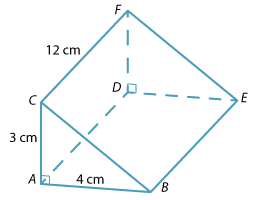![]()
Volume of triangular prisms
In a triangular prism, each cross-section parallel to the triangular base is a triangle congruent to the base.

Suppose we have a triangular prism whose height is 4 cm as shown in the diagram.
This prism can be thought of as the rectangular prism with dimension 2 × 3 × 4 cut in half.
Hence the volume of the triangular prism = \(\dfrac{1}{2}\) × 2 × 3 × 4 cm³
In this case, the base of the prism is a right-angled triangle. The lengths of its shorter sides are 2 cm and 3 cm respectively.
The area of the triangle:
\begin{align}A &= \dfrac{1}{2} × 2 × 3\\\\ &= 3\ \text{cm²}.\end{align}The volume of the prism is given by the area of the base of the prism multiplied by the height:
\begin{align}V &= 3 × 4\\ &= 12\ \text{cm³}.\end{align}So the volume of any triangular prism whose base has area A and whose height (or depth) is h is given by:
Example 2
Find the volume of the triangular prism pictured. All measurements are in centimetres.
Solution
\begin{align}V &= Ah\\ A &= \dfrac{1}{2} × 3 × 4\\ &= 6\ \text{cm²}.\\ V &= 6 × 12\\ &= 72\ \text{cm³}.\end{align}





